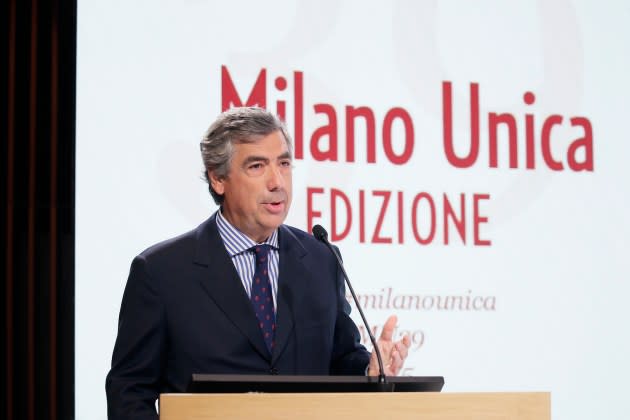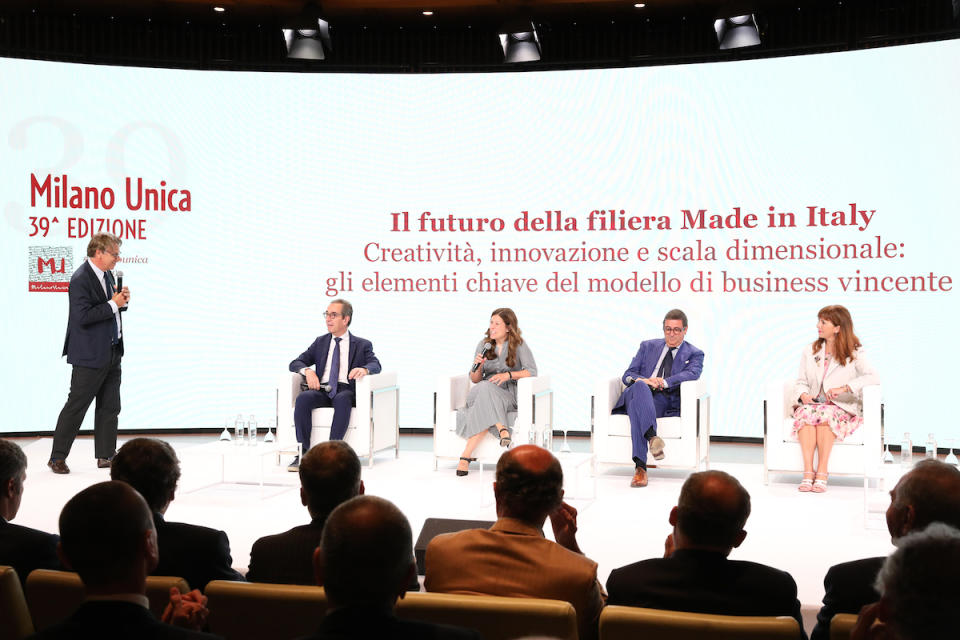
Italian textile trade show Milano Unica kicked off its 39th edition Tuesday with 18 percent more exhibitors than last year’s event, and 22 percent more than its pre-Covid 2019 show.
The three-day event has relocated to a larger location with the Fiera Milano Rho exhibition center on the outskirts of the fashion capital, which provides just under 25 percent more space to accommodate the growing interest.
More from Sourcing Journal
With 700 exhibitors—569 of which are participating in the show’s three exhibitions: Ideabiella, Moda In and Shirt Avenue, and the remainder divided between the special areas and the Korea and Japan observatories—all of Italy’s unique textile districts were “fully represented” in both terms of the number of participating companies and the “full range” of their offerings, the textile fair said in a statement.
Italy’s textile districts are concentrated in Biella, Prato, Como, Busto Arsizio and Vicenza, with specialties ranging from wool to silk, knitwear, recycled textiles, hosiery and more.
“I think Milano Unica represents—at the international level—one of the most important events for manufacturers on one hand, and on the other, for buyers of high-quality fabrics and accessories,” said Simone Canclini, the show’s newly-elected president. “The products showcased are characterized by innovative style, designed to meet all the needs of the entire sector downstream, with a focus on sustainability and circular economy.”
While the industry is facing certain challenges, including a negative trend in production and commercial activity that’s been lingering since last year, the increase in attendance underscores Milano Unica’s importance as a platform for premium and luxury manufacturers. The first quarter of 2024 recorded a “general decline” in Italy’s domestic production and international trade, emphasizing double-digit drops in both exports and imports throughout various product segments.
Only exports to China and Hong Kong revealed data went against the downward trend, solidifying the countries’ status as the first export markets for made-in-Italy products, the organization said. It’s also worth noting that even though the industry tends to place Italian-made textiles at the highest end of the spectrum, these goods are still affected by the performance of the luxury sector on the global scale, Milano Unica leadership said.
“Over the years, the market has undergone differentiation. At Milano Unica, we have always privileged excellence in materials and technological research on processing, and the trade show has developed into a point of reference in these complex market scenarios,” Canclini said. “Indisputably, Milano Unica is experiencing a very favorable moment, despite the difficult situation of the textile industry, but I am convinced that an even greater attention to quality standards will enable made-in-Italy manufacturers to react to the situation and build a future.”
The three-day event, which runs from July 9-11, will see the Fall-Winter 2025-2026 collections showcased, emphasizing “a journey through European and Italian excellence.” There’s extra attention placed on sustainability and innovation, with new entries including MarediModa and Velvet Mi Amor by Stefano and Corinna Chiassai.
“This edition closes a circle and opens another one,” Canclini said. “It closes a circle because the excellence of all the Italian textile districts lines up compactly and it opens a new one because it represents a starting point for the growing consolidation of Milano Unica’s international role.”

The show’s opening ceremony featured commentary from Attilio Fontana, president of the Lombardy Region, and Matteo Zoppas, president of the Italian Trade Agency ICE. The future of the made-in-Italy value chain was examined during a roundtable discussion featuring Barbara Cimmino, vice president at Confindustria with responsibility for exports and investment attraction and co-founder of Yamamay; Antonio De Matteis, president of Pitti Immagine and CEO of Kiton; Luca Solca, analyst and head of luxury goods at Bernstein; and Caterina Sanson, partner at OC&C Milan. Business and finance journalist Nicola Porro moderated the panel.
“The success of Milano Unica gives us great satisfaction and, even more gratifying, is the knowledge that this is the fruit of the commitment and dedication of Milano Unica’s executive committee to this great project, supported by the entire team,” said Massimo Mosiello, general manager of Milano Unica.
Mosiello thanked the Italian Ministry of Foreign Affairs and International Cooperation and the Italian Trade Agency ICE for the Internationalization of Italian Companies Abroad, “which, season after season, have been supporting us in making Milano Unica a point of reference for the excellence of textiles and accessories and for an increasingly demanding public.”
The general manager said that the show has also solidified its partnership with the Italian Trade Agency. “This derives from the recognition of the important strategic work performed by the management, which led to achieving excellent results on international incoming and the implementation of all communication activities,” Mosiello said. “I would also like to thank our loyal partners, Banca Sella and Lauretana, for their valuable support.”
EMEA Tribune is not involved in this news article, it is taken from our partners and or from the News Agencies. Copyright and Credit go to the News Agencies, email news@emeatribune.com Follow our WhatsApp verified Channel





